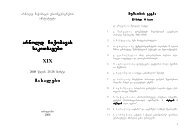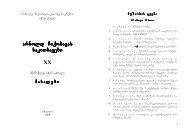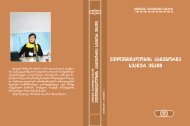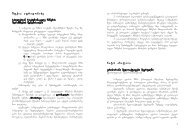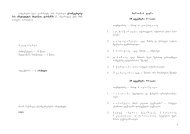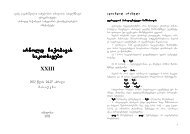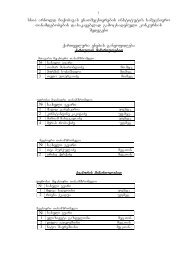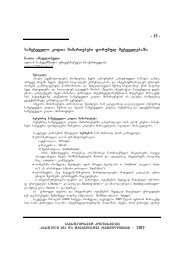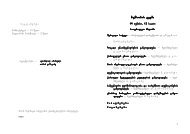5 r. a b a S i a (Tbilisi) bgeraTSesatyvisobis erTi rigisaTvis qarTvelur ...
5 r. a b a S i a (Tbilisi) bgeraTSesatyvisobis erTi rigisaTvis qarTvelur ...
5 r. a b a S i a (Tbilisi) bgeraTSesatyvisobis erTi rigisaTvis qarTvelur ...
Create successful ePaper yourself
Turn your PDF publications into a flip-book with our unique Google optimized e-Paper software.
sual types of subordinate clauses and, in the same time, they play the role of<br />
means of connection between the syntactical units.<br />
The participle is characterized with the variety of forms and ways of forming<br />
concerning the time and aspect of action.<br />
There are only two forms of the participle which have morphological status.<br />
They are “independent” participles of the past tense (aku-r “seen”, fe-yi<br />
“past”) and the future tense (akva-r “will see”, fi-r “will go”). In the last case<br />
there is the same interrelation between the future and the present tenses, which<br />
are defined by the context and don’t have any special lingual expression. Other<br />
forms of the participle called “interrelated”, “contextual”, in their unsubstantivized<br />
forms don’t differ from those of corresponding forms of Indicative. Being<br />
innovations (compound in structure), correlating participles, as it is, are more<br />
sustained and more concretely double the meaning of time of the independent<br />
participles, i.e. the episode in the future is defined by three main forms making<br />
time portions more definite: akunvai “having seen”, akvazvai “seeing” (usual<br />
present tense), akvazmai “still seeing” (the Present Continuous tense), akvadai<br />
“will see” (general future tense).<br />
The differences and peculiarities in formation of these types of the participle<br />
reflect different nature of the tense they express, as well as special stages<br />
in the development of the verb in the Lezgian language.<br />
The stems of the independent participles are connected with the formation<br />
of the grammar time. They are more productive and fulfill a very constructive<br />
role. The basic paradigm of the verb is built on these two stems exactly.<br />
Thus, the stem producing the form of the simple participle of the past tense can<br />
be found in the formation of verbal forms in the past tense. Consequently, the<br />
stem of the future tense and the stem of the unreal tense coincide. This case is<br />
not a pure coincidence, as well as homonymic oppositional stems which form<br />
these two participles. There exists a sort of correlation, members of which are<br />
the forms of time and aspect, or they function in the sphere of finished / unfinished<br />
action.<br />
The basic syntactical peculiarity of the participle is its forming of participial<br />
constructions, which are not alike according to their semantics and syntax:<br />
some have a special subject different from that of the main predicate, others<br />
don’t have it.<br />
19



